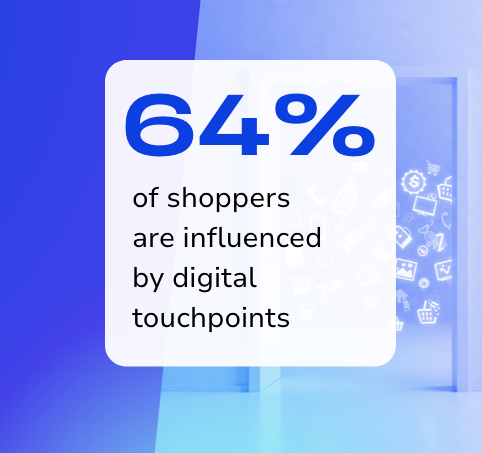
Over the past decade, consumers have turned into omnichannel shoppers — meaning they shop in-store and from various brand or retailer online sources, including websites, apps and social media pages.
New research from Profitero+ reveals that 64% of retail sales are digitally influenced, meaning that most shoppers have engaged with brand content online — like ads, social media posts or website pages — influencing their decision to purchase online or in-store.

Walmart has reported that 81% of shoppers consult the retailer’s app or website before shopping in-store. And people aren’t just visiting a store’s website in advance to validate their purchases — they’re checking retailer websites or apps while in-store: 82% consult the Walmart website or app when shopping for food & beverage products in store.

Source: Walmart Connect
The digital shelf opens a new world of opportunity for category managers eager to optimize the shopper experience and strengthen their retailer-partner relationships.
A traditional brick-and-mortar category management approach relies on market research and point-of-sale data. These sources tell the story of what people want to buy, how much and when, but it’s not the complete picture anymore. That’s where digital shelf analytics come in.
Need a refresher on what the Digital Shelf is and why it’s important? Check out our deep dive here.
Today, shoppers navigate online and in-store landscapes when making purchases, so a holistic category management approach is essential to meet omnichannel shopping expectations.
Instead of just a physical shelf, we now also have a “digital shelf” that serves as the doorway to all retail sales.

By combining data from in-store point of sales, market research, online search data and eCommerce sales data, category managers can create a comprehensive view of the shopping experience that generates more revenue — both online and in-store.
Without digital shelf analytics, category managers can’t fully understand all the dynamics impacting the omnichannel shopper experience. The more category managers can integrate digital shelf analytics within their processes and strategies, the more value they can unlock and the more essential they become to their retail partners.

Where are critical gaps in our assortment relative to our competitors?
Online search results can now answer what was once a question only answered by Circana (formerly IRI) or Nielsen POS data. How? Retailer search results will contain all the products they sell in-store plus any additional selection they only offer online.
These online-only offerings include specialty niche brands retailers are testing for distribution, unique price pack configurations that appeal to customer value needs, and virtual bundles where retailers combine complementary products for sale. Furthermore, online search will capture products in 3P marketplaces (like on Walmart & Amazon), which you wouldn’t capture in POS data. This will give your customers a more robust view of product assortments across top competitors.

What are consumers’ critical unmet needs in the category?
The old way of answering this question was through market research. Nowadays, category managers can identify their consumers’ likes, dislikes, and needs by looking at online product reviews. They are a goldmine for insights that can inform new product development and can help when it comes to planning for incremental sell-in opportunities with retailers.

Have we organized our planogram to match how consumers shop categories?
In the past, category managers relied on sales data to develop planograms and consumer decision trees. Now, you can create consumer decision trees using search behavior data. Keywords represent the way consumers think about your categories online. By understanding which keywords consumers are using and on which retailer, category managers can help retailer customers design an optimal path to purchase.


Are my competitors' prices lower?
In-store POS pricing is no longer a viable way to answer this question. Why? Because online prices are often different in-store and change dynamically as retailers use algorithms to match promotions. Category managers must monitor their online pricing to ensure retailer price matching doesn’t result in a “race to the bottom” pricing scenario that can destroy value across the category.
The category manager’s job is to help retailers see where competitors have lower prices and where they may be contributing as first movers in lower pricing across the category.

Source: Profitero+
Do we have the right price points for the category?
Regarding the right price points, our advice is the same. Don’t rely on traditional price-per-unit analysis of in-store data; analyze price per unit using online data. Since retailers offer more variety of pack options online than in-store, you need to account for online data to identify key opportunities and gaps in your current offering. Retailers must get this right with current inflationary headwinds and increased risk of losing share from dollar stores.

What is our competition doing differently to merchandise products?
The old way of understanding how the competition was merchandising products was to analyze their endcaps in-store. When it comes to online, it’s all about exploring brand content on the retailer’s site.
Content is a digital form of merchandising. If consumers cannot find enough information to evaluate products, they will look for it on another retailer’s site. It’s imperative to make your retail consumers aware of gaps and opportunities to level up their content game.
Reminder: Not all retailers or categories are created equal. Ensure you first understand what you can do on retailer sites (we've got a tool for that, check it out here.). Then, prioritize what you should do to increase traffic and conversion with Content Optimizer.
At Profitero+, we use a data science methodology that analyzes bestseller PDP content to establish best practices. These benchmarks vary widely, even across similar categories. What converts on Amazon won’t necessarily work at Walmart.
Not surprisingly, more and more people are turning to digital-first in their consumer journey as the landscape shifts towards millennials and Gen Z. The future is digital, and category managers that infuse digital shelf insights into their traditional 4P frameworks and conversations with retailer partners will be the best positioned to win.

Read our latest report the Digitally Influenced Shopper here.


